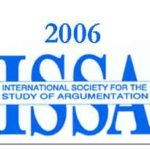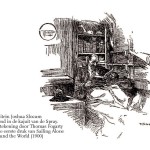ISSA Proceedings 2006 ~ The Criminal Abduction Paradox
 Abstract
Abstract
In criminal trials at common law there is an apparent clash of legal principles. On the one hand, a jury cannot convict an accused except on a finding of guilt “beyond a reasonable doubt.” On the other hand, juries base their verdicts on what they take to be the best “theory of the case”. A theory of a case is a conjecture that best explains the evidence led at trial. Theories of the case are therefore exercises in abduction. Since abduction is intrinsically conjectural, it is difficult to see how any theory of the case could meet the proof standard of guilt beyond a reasonable doubt. The present paper offers a possible solution of this apparent paradox.
Key words: abduction, activation, conjecture, criminal standard, explanation, hypothesis, ignorance-problem, proof, reasonable doubt, reasonable person, verdict
1. Verdicts as abductive
In the common law tradition, a conviction at the criminal bar is constituted by a verdict of guilt beyond a reasonable doubt.[i] Verdicts reflect an interpretation of the evidence heard at trial and an assessment of the competing parties’ theories of it. A theory of the evidence is also called an “argument”, presented as an address to the jury. An argument in this legal sense is grounded in an inference to the best explanation, which is the most common form of abductive reasoning. So we may say that a guilty verdict is the conclusion of a suitably strong abduction, and that a verdict to acquit is a judgement to the effect that the evidence permits no abduction of requisite strength. A jury’s task is to adjudicate between the rival abductions proffered by opposing counsel in their closing statements. It is also possible that a juror might reject the arguments advanced by counsel and make his own interpretation of the evidence. Either way, the jury’s task is complicated by the fact that nearly always the sum total of the evidence heard at trial is internally inconsistent. This gives all three parties – prosecution, defence and jury – occasion to trim the evidence with a view to reining in its inconsistency. This is done in one or other of two ways, singly or in combination. Juries will either base their determinations on a consistent proper subset of the total evidence, or they will form subsets of it that retain some of the inconsistency, but assign to its competing elements different weightings. It is therefore entirely commonplace that the abductions advanced by opposing counsel proceed from different subsets of the total evidence. Nor is it uncommon that the evidence tied to the jury’s own abduction is yet a different subset of the evidence, although usually they overlap fairly significantly. Accordingly, a lawyer’s address to the jury will typically have two components. One is a presentation (sometimes implied rather than expressed) of reasons for selecting his particular subset of the evidence. The other is the advancement of what he takes to be the best explanation of it. By the time a case goes to the jury, it is often the case that the trier of fact is faced with two rival abductions explaining two rival bodies of evidence. It falls to the trier of fact to assess not only the strength of these rival abductions, but the soundness of the evidence-selection choices to which they are tied. Read more
Photo’s Lisette-Mejia – 14 Tiny Homes That’ll Make You Want To Move In ASAP
ca.shine.yahoo.com. November 2014. You’ve seen models of small houses before, but wouldn’t it be nice to see tiny homes in action? Ahead, we’ve rounded up pictures with the #tinyhousemovement hashtag on Instagram. What is the tiny house movement, you ask? A trend where people live in teeny homes on wheels that measure anywhere from one square meter to 700 square feet – the whole point is that they’re affordable, movable, environmentally friendly, and most of all, perfect for living a simple life. As these photos prove, they’re pretty darn attractive, too.
See & enjoy: https://ca.shine.yahoo.com/photos/14-tiny-homes-thatll-want-slideshow/
ISSA Proceedings 2006 ~ The Rules Of The Critical Discussion And The Development Of Critical Thinking
 The purpose of this paper is to discuss the concept of critical thinking as an operative concept that makes it possible to generate a strategy for developing critical abilities in the students and, in this way, to achieve one of the most important objectives of the Chilean Educational Reform.
The purpose of this paper is to discuss the concept of critical thinking as an operative concept that makes it possible to generate a strategy for developing critical abilities in the students and, in this way, to achieve one of the most important objectives of the Chilean Educational Reform.
It is evident that the concept of critical thinking is vague. Many authors have different perspectives about this concept and, to same extent, they contradict each other. My intention is not to intervene in this controversy, but to look for a solution in a different direction. This means using a methodology that allows us to determine some basic characteristics of the concept of critical thinking avoiding dealing with general conceptions of the concept. The main objectives are then to establish a list of the most important characteristics that allow the development of critical thinking among the students.
1. Conceptual analysis
What I am going to do is to analyze the concept of critical thinking in the same way that anyone would analyze concepts such as democracy, education, science, etc. I will make use of the technique of conceptual analysis as developed for John Wilson (1960, pp. 1-49). In Wilson’s conception, these concepts are called philosophical concepts, because even though we know how to use them in some contexts, we do not know the boundaries of each concept or, simply, such limits are open or don’t exist. We know, nevertheless, some typical cases that are central to the concept. This means that nobody that would use these concepts could ignore them as instances of such concepts. So we can use these instances in order to obtain some specific characteristics of the concept, and we can avoid the difficult task of defining the general concept of critical thinking.
In the case of critical thinking, one of the central instances is, of course, logical abilities, or more specifically, the ability to infer consequences from some principles or assertions. It would be strange to say of a student that cannot infer consequences in a correct way that he is a critical person. It is obvious that one of the main characteristics of a critical student is the ability to distinguish between correct arguments and fallacies or incorrect arguments. Therefore, Wilson’s methodology consists in dealing with specific instances of the concept, the central ones in the first place and, then, we continuing attempting to explore the limits of the concept analyzing the consequences that follow from each of these instances. What does logical ability imply? Read more
ISSA Proceedings 2006 ~ A Discussion Of Habermas’ Reading And Use Of Toulmin’s Model Of Argumentation
 Introduction
Introduction
It will probably be useful to start with some contextualization of the discussion. Apart from a desire to better understand both Habermas and Toulmin, the starting point here is a research and teaching interest in applied ethics. Difficult epistemological problems are raised especially concerning environmental issues. We find ourselves in need of seeing excellent environmental practices adopted if possible by all the major players, whether it be companies or countries, while at the same time the decision makers are affected by risk assessment problems and uncertainties that require modal judgments, using probability or the like. As we will see, those issues are central to the discussion of Habermas’ reading and use of Toulmin.
Habermas contributed in an extraordinary way to normative thinking since the 1960s. He asserted the foundational nature of his theoretical work, especially in the period of the Diskursethik and his Theory of Communicative Action (beginning of the 1980s). Still quite recently, he presents himself as part of what he calls pragmatic Kantianism (Habermas, 2003, 2, p. 16). Throughout his work, he is looking for some rational validation of moral principles, and in a kantian manner he wants to arrive at this justification by means of a universalizing procedure, but according to him, this should proceed in considering first and foremost discourse practices. Any norm implies that some action is required, or forbidden; in considering the consequences, could all persons affected by the norm agree on it? (Habermas, 1983). We must remember also that he adopts a cognitivist perspective on moral issues, which means he does not want to let moral evaluation or prescription rely on emotion or on the will, but wishes to understand normative problems as susceptible of rational solutions. Those elements explain in part why he refers to the so-called Toulmin model, especially between 1972 and 1983: it refers to rationality, to argumentation and seems to permit universalization. In 1972, Habermas’ purpose is not to give a precise presentation. In fact, even in 1981, his use of Toulmin is rather rhetorical and selective. He is mobilizing Toulmin to serve his foundational project, which should not come as a surprise.
On the other side, it is also clear why Toulmin still has an enormous importance today in ethics, in particular (among other things) in decision making situations. Modals and rebuttals are of the foremost importance if we are to make decisions and judgments while taking into account context and possible exceptions. In the problem domain of environmental ethics, where risk issues and decision processes in quite uncertain situations are regularly required, this is even more the case. Those are difficult issues to treat and the available knowledge is far from the level of certainty most people would prefer for making decisions.
Here I will briefly recall some of Jürgen Habermas’ theoretical work, and limit the focus to the use by Habermas of Stephen Toulmin’s model of argumentation, especially in the article Wahrheitstheorien that is not translated in English yet.[i] The article will be looked at in detail.[ii] I will conclude by looking at the 1981 treatment and to what happens with the issue in later work (especially Habermas, 1983 and Habermas, 2003). Read more
NARCIS – National Academic Research and Collaborations Information System ~ Urban Studies
 NARCIS: The gateway to scholarly information in the Netherlands. Urban Studies: 858 publications – 14 datasets – 172 research projects
NARCIS: The gateway to scholarly information in the Netherlands. Urban Studies: 858 publications – 14 datasets – 172 research projects
NARCIS is the main national portal for those looking for information about researchers and their work. Besides researchers, NARCIS is also used by students, journalists and people working in educational and government institutions as well as the business sector.
NARCIS provides access to scientific information, including (open access) publications from the repositories of all the Dutch universities, KNAW, NWO and a number of research institutes, datasets from some data archives as well as descriptions of research projects, researchers and research institutes.
This means that NARCIS cannot be used as an entry point to access complete overviews of publications of researchers (yet). At the national level, however, there are plans to incorporate the publication data from the academic Metis systems in NARCIS. By doing so, it will become possible to create much more complete publication lists of researchers. In addition, NARCIS presents research news from, among others, Intermediair Nieuws, Science Guide and several universities.
In 2004, the development of NARCIS started as a cooperation project of KNAW Research Information, NWO, VSNU and METIS, as part of the development of services within the DARE programme of SURF foundation. This project resulted in the NARCIS portal, in which the DAREnet service was incorporated in January 2007. NARCIS has been part of DANS since 2011.
Go to: http://www.narcis.nl/urban%20studies
ISSA Proceedings 2006 ~ Arguing With Asperger Syndrome
 1. Introduction
1. Introduction
The study examines the argumentative competencies of people with Asperger syndrome (AS) and compares this with those of normal – or what are called neurotypical (NT) – subjects. To investigate how people with AS recognise, evaluate and engage in argumentation, we have adapted and applied the empirical instrument developed by van Eemeren, Garssen and Meuffels to study the conventional validity of the pragma-dialectical freedom rule (van Eemeren, Garssen & Meuffels 2003a; 2003b; 2005a; 2005b; van Eemeren & Meuffels, 2002). Our paper begins with some background information on Asperger syndrome and how it impacts upon communication and argumentation; then it addresses the research questions and methods used; thirdly, it presents some initial findings; finally, it will conclude with some implications for those people with AS, for those they come into contact with and for the pragma-dialectic model in general.
2. Asperger Syndrome (AS)
Asperger Syndrome is a neurological disorder named after Hans Asperger. In 1944, Asperger published a paper that described patterns of behaviour in young men who had normal intelligence and language development, but who also had deficiencies in social and communication skills. Despite being identified in the 1940s, Asperger syndrome (AS) is a relatively new category of developmental disorder, and was only ‘officially’ recognized in 1994, in the fourth edition of the Diagnostic and Statistical Manual (DSM IV) of the American Psychiatric Association. AS is often associated with what is called the high functioning end of the autistic spectrum (Frith, 1991) although there is considerable debate about whether AS is high-functioning autism, or something else (Frith, 2004). It is generally accepted that AS, like autistic conditions, is a neurologically-based developmental disorder, in which there are deviations in three broad aspects of development: first, social relatedness and social skills; second, impaired communication, and a lack of pragmatic skills in particular; and third, certain behavioural characteristics involving repetitive, or what are called perseverative features, often accompanied by an intense interest in a limited range of subjects. It is the level of deficiency in these three categories – social-relatedness, communication & behaviour (which Wing (1993) has called the “triad of impairments”) – which can range from relatively mild to severe, that defines all of the pervasive developmental disorders, from those with mild AS through to the profoundly autistic. Read more



